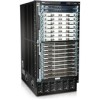Dell PowerConnect J-8216 Hardware Guide - Page 57
N+N Redundancy Configuration of AC Power Supplies
 |
View all Dell PowerConnect J-8216 manuals
Add to My Manuals
Save this manual to your list of manuals |
Page 57 highlights
Chapter 2: Component Descriptions The following tables list the N+1 power requirements for different AC power supplies: • Table 21 on page 41-Lists the N+1 power requirements of J-EX8216 switch configurations that use 2000 W AC power supplies. • Table 22 on page 41-Lists the N+1 power requirements of J-EX8216 switch configurations that use 3000 W AC power supplies. Table 21: N+1 Power Redundancy Configurations for J-EX8216 Switch Configurations Using 2000 W AC Power Supplies Switch Configuration Input Voltage Power Supplies Needed (N) Power Supplies Needed for N+1 No line cards High line (200-240 VAC) 2 3 installed Low line (100-120 VAC) 2 3 Fully loaded with 8-port SFP+ line cards High line (200-240 VAC) 5 Low line (100-120 VAC) Not supported 6 Not supported Table 22: N+1 Power Redundancy Configurations for J-EX8216 Switch Configurations Using 3000 W AC Power Supplies Switch Configuration Input Voltage Power Supplies Needed (N) Power Supplies Needed for N+1 No line cards High line (200-240 VAC) 1 2 installed Fully loaded with High line (200-240 VAC) 4 5 8-port SFP+ line cards N+N Redundancy Configuration of AC Power Supplies You can optionally configure your switch for N+N redundancy, in which N power supplies can be removed or fail and the remaining N power supplies continue to supply power for the switch without interruption. A common application for N+N redundancy is to have a dual power feed for AC power supplies. When you configure power management for N+N redundancy, power management lowers the chassis maximum power consumption by lowering the maximum fan speed. It does so to compensate for the fact that because more power is held in reserve in an N+N configuration than in an N+1 configuration, less power would ordinarily be available to power line cards. By reducing the chassis maximum power consumption, power management allows the switch to power more line cards. The AC power supplies (2000 W or 3000 W), the number and type of line cards installed in the switch, and the input voltage determine the number of power supplies needed (N) for the switch. You must then install additional power supplies to meet the N+N 41















